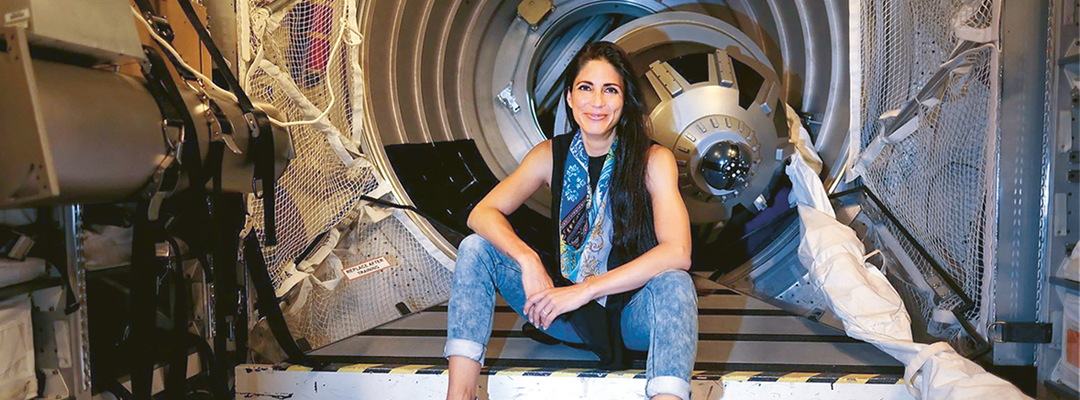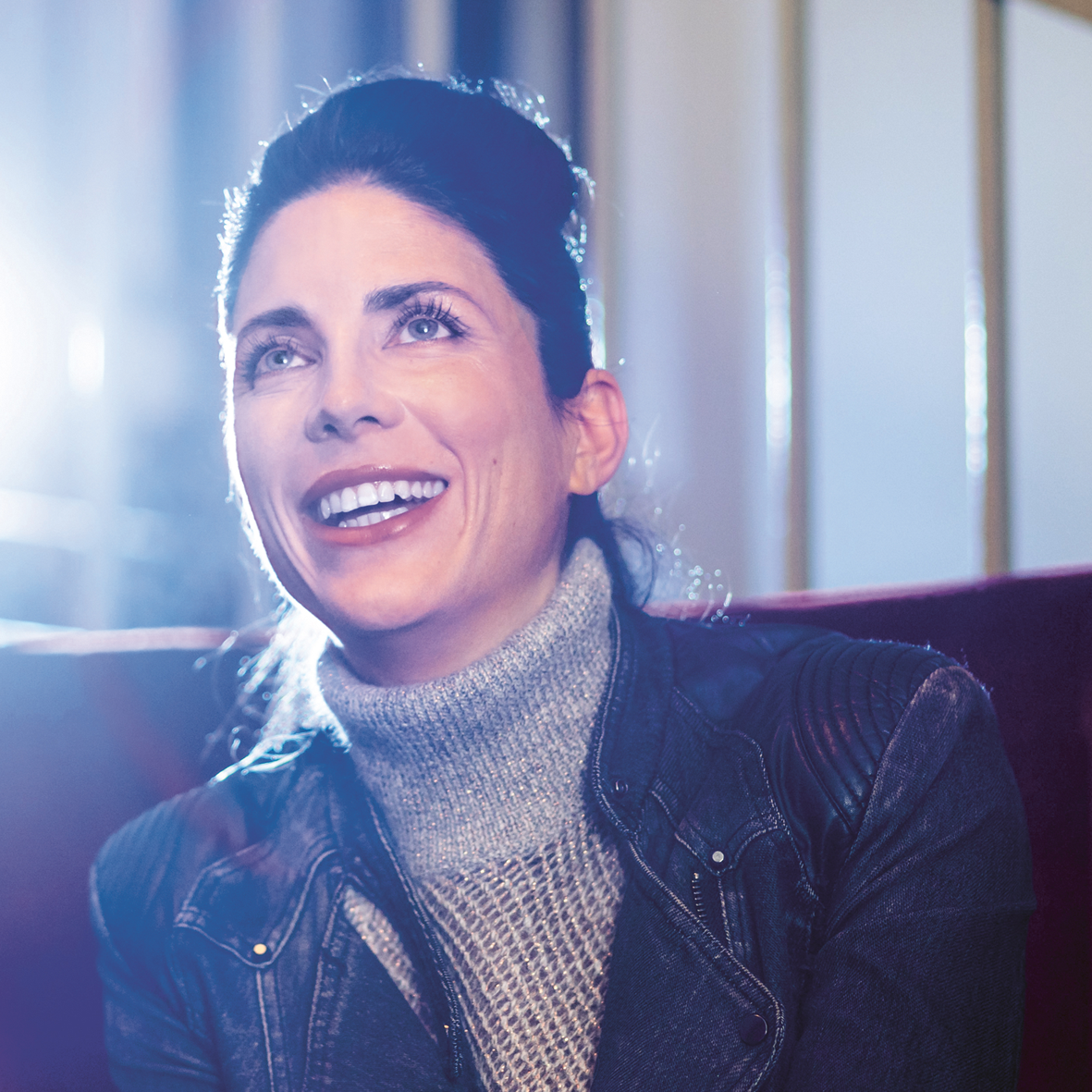
Annual Report 2020
PERSPECTIVES AND DREAMS

Interview with Laura Winterling: physicist, former astronaut trainer, and entrepreneur – with a passion for the natural sciences.
‘ENERGY’ – WHAT IS THE FIRST THING THAT THIS WORD MAKES YOU THINK OF?
LAURA WINTERLING Physics, actually. Energy is a physical variable for me. I am a qualified physicist and immediately think of my physics lessons, plate condensers for example. Nothing works without energy. A plate condenser without an applied voltage is simply two plates and nothing more. Electrical voltage is the driving force that causes movement of the charge. Basically, the higher the voltage, the more electricity can flow. Voltage is something that we need to get things moving.
IS THIS ALSO THE CASE FOR US HUMANS?
LW Yes. It’s exactly the same in our bodies. There is always a potential gradient of minus 70 mV along the nerve paths. Otherwise nothing would be able to flow – no sodium or potassium ions, nothing. We need this voltage to activate our muscles, for example, so that we can move and think. In nature, everything requires a gradient for movement. Balance is not desirable here.
NATURE AND HUMANS: DO YOU SEE A CONFLICT HERE?
LW The world tends towards disorder – this is one of the main statements of physical thermodynamics. The physical law is called the law of entropy in scientific jargon. We all grow up, me too, in a society that now is totally based on balance and order. This leads to internal friction when, for example, nature and the environment do not behave or develop in a way that corresponds with our sense of order or our expectations. This also causes conflicts that challenge us and constantly drive us towards further development. Ultimately, this is also what drives humans to want to reach into space.
SPACE TRAVEL SHIFTS AND OVERCOMES BOUNDARIES INCLUDING, IN PARTICULAR, THE TENSIONS CAUSED BY NATIONAL AND CULTURAL BORDERS. WHY DO THINGS THAT OFTEN APPEAR DIFFICULT ON EARTH FUNCTION BETTER IN SPACE?
LW The International Space Station ISS is, as the name suggests, an international collaboration – between five large space agencies from five nations, operated and developed with the involvement of more than 60 countries that work together on the edges of scientific knowledge. That they can actually work together in peace is already an excellent achievement. And the crew doesn’t do this down here around the conference table, but up there in space. The change of perspective helps. The fact that it works depends mainly on the basic attitude of the people who carry out these projects, our astronauts. And, of course, the trainers – I don’t want to leave us out. Those who complete this task at an altitude of 400 km, however, have a particular inner attitude that is absolutely decisive for what we call ‘success.’ A project does not work because one brings the people together and simply says, “Get to work on the project.” It works because each individual involved has understood what ultimately matters before one does that. And it works because everyone wants it to. But why does everyone want that? I am also unable to explain it fully, but it is roughly like when one asks a climber why they are so keen to get up an 8,000-meter mountain. What do they say? Well, because it’s there.
WHAT DO ISS ASTRONAUTS NEED FOR THEIR COLLABORATION TO FUNCTION AT AN ALTITUDE OF 400 KM? HOW ARE DECISIONS MADE AT 28,000 KM / H EVEN IN STRESSFUL SITUATIONS?
LW Let’s consider a Soyuz rocket launch. That’s an exciting and extreme situation. Three people are sitting in this little capsule curled up with their knees on their chests. These three people have trained for this mission for three long years. Every day. They are the best in their countries, have the best training, have got through the selection process. They have made sacrifices during these three years; have not been able to see their families. They have really concentrated hard for this moment. And despite all this, only one of them can take the Commander’s seat in this rocket. And there was no wrangling about it. The Commander sits in the middle, flanked by the flight engineers. The Commander is accepted by the others. The other engineer and I, we know that the Commander is not better than we are – but someone has to do it. And so I also follow him. I must not have any ego problem at all. Because one cannot endlessly discuss decisions in the capsule, but must act. One person alone points the way – to prevent chaos
CAN ONE TRANSFER EXPERIENCES IN SPACE TO ONE’S EVERYDAY LIFE, BRING THEM BACK TO EARTH SO TO SPEAK?
LW We sometimes miss this shared objective. When the astronauts are sitting in the capsule and lifting off from earth with 26 million horsepower they no longer have any egotistical goal: It’s not me on my own. We are a team. The best team that I could imagine. There is no competition in the rocket. Considered in physical terms, stress is also a form of energy. Positive stress, eustress, can be something good because one needs it to keep moving forwards and not just lie around on a sofa. Nothing happens any more if we remove this energy. So there are also advantages that come because one cannot simply lie around in space without gravity. One has to maintain this inner tension if one wants to keep moving. I can only advise anyone who suffers a brief trough to open their eyes in the morning and first feel their presence and think to themselves: I am living in a house, in a safe country that is located on a piece of Earth that is currently orbiting a star at an unbelievably fast speed in space. We do not have more than this. This thought helps me. Not always, I admit, but the thought at least makes me smile. Something that really helps to get one going early in the morning.

THE ISS IS THE WORLD’S BIGGEST TECHNOLOGY AND RESEARCH PROJECT ABOVE THE SURFACE OF OUR EARTH. AS A PHYSICIST, WHAT DO YOU THINK ARE THE MOST INTERESTING AND IMPORTANT RESEARCH PROJECTS?
LW I really think that the biggest experiment, the biggest achievement, is that it provides an example of how people from the most varied of nations, nationalities, cultural backgrounds and languages can work next to and with one another. It’s easy really. Space is probably the biggest social project ever undertaken. The ISS, however, is first and foremost a space laboratory for experiments in the most diverse of disciplines. Whereby, among other things, the ISS provides important information on Earth conditions regarding icebergs, wave movements, ship movements, currents, the melting of ice in Greenland or at the Antarctic, changes in cloud formation. These things are best observed when one looks at them from the outside – the key thing here is the change of perspective. I personally often need to change my perspective! And the most different point-of-view currently possible for us as humans really is that from the ISS, from the wonderful – almost 360° – window. I have never been up there myself, or only in my dreams. One should anyway dream a dream to the end, whether it is fulfilled or not. This also has something to do with energy. That’s where motivation comes from.
Laura Winterling, former astronaut trainer and entrepreneur
After taking university entrance examinations and a year abroad in the USA, Laura Winterling studied physics at Bayreuth University. On completing her studies, she worked as an Astronaut Support Officer in the European Space Agency (ESA) in Cologne and spent almost ten years training more than 80 international astronauts in the European space systems of the ISS. She has since gone freelance and is Managing Director of Space Time Concepts GmbH. She organizes tours at the European Astronaut Centre (EAC), and gives talks on manned space flights and the everyday work of astronauts to companies and other interested parties. As a motivation trainer, she advises companies on change and leadership projects, among other things. spacetimeconcepts.com







